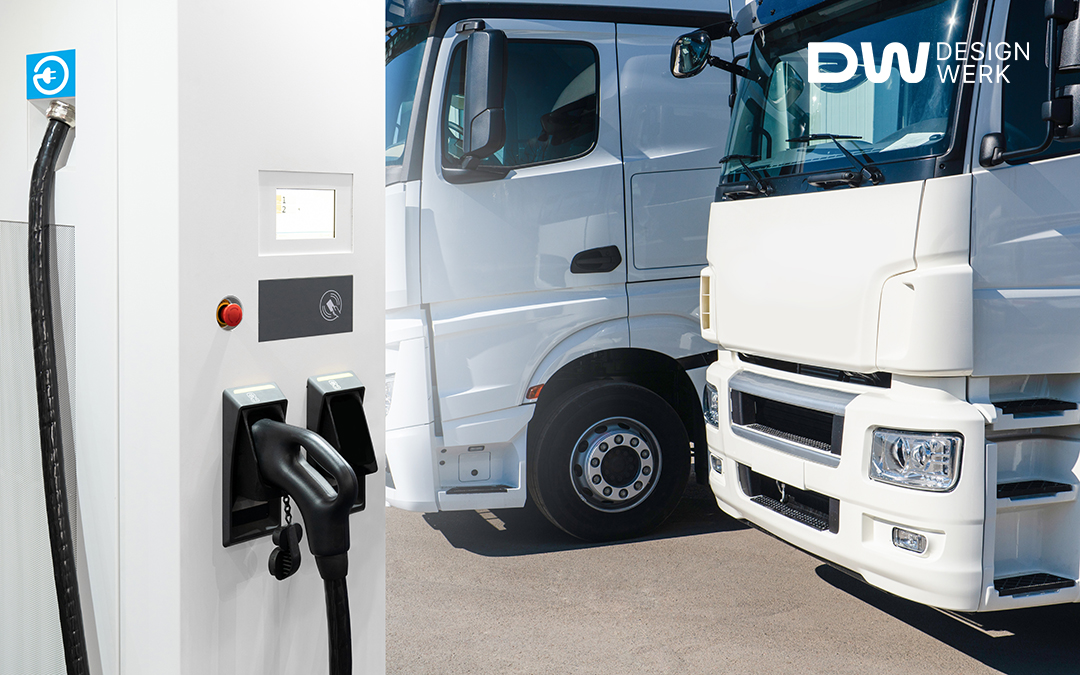With the burgeoning significance of e-mobility, electric vehicles and charging stations have become a ubiquitous sight on our roads. This electrifying wave has also surged into the realm of trucks, with Germany alone registering a substantial 43,400 electric trucks at the outset of 2022. As e-trucks become more commonplace, the need for swift and efficient recharging methods is paramount. But what’s the optimal approach, and how does the charging process unfold?
In essence, electric trucks can be charged wherever a wallbox or high-voltage socket is available, offering various methods:
Direct Charging: Electric trucks can be directly charged at the vehicle using an AC socket equipped with a CCS Type 2 plug or a Juice Booster. In instances where long breaks aren’t feasible and the journey must continue promptly, DC plug charging (ranging from 22 kW to 350 kW) is an option. On-board charging is another avenue.
Designwerk e-Truck Charging: Designwerk e-trucks come equipped with a 22 kW charger as standard, with the option to connect a second charger for a total of 44 kW charging capacity. Additionally, mobile fast chargers, converting alternating current into direct current, can be flexibly employed, offering up to 88 kW charging power thanks to their compact design.
Mega Charges: A new generation of charging stations, known as Mega Charges, is now available. These stations are capable of rapidly replenishing truck batteries within minutes, relying on a standardized plug that delivers power in the megawatt range.
The charging process is straightforward and secure, incorporating an interlock mechanism to prevent unauthorized disconnection. Plug in, verify the charging power, monitor the visual display, disengage, and hit the road. Once the electric truck is fully charged, the charger automatically shuts off, ensuring a seamless and efficient experience. Welcome to the future of electric truck charging.
 A mobile charger by Designwerk. Photo: Designwerk.
A mobile charger by Designwerk. Photo: Designwerk.
AC vs. DC and Fast Charging
All well and good. But after driving for a maximum of 4.5 hours, it’s mandatory to take a 45-minute break, and during this time, the truck needs to recharge enough electricity for another 4.5-hour journey. The standard charging system in Europe and North America, known as CCS, can only deliver 500 kW of power. High Power Charging (HPC) speeds up CCS charging by cooling the cable and plug, allowing for a maximum power of 500 kW.
However, there’s an even faster system on the horizon called the Megawatt Charging System (MCS). It’s going to boost the maximum voltage to 1,250 volts and the maximum current to 3,000 amperes, aiming for a charging capacity of up to four megawatts. In its initial market launch, it will offer one megawatt of peak power.
When it comes to charging an electric vehicle, there are two main types: AC and DC charging. Fast charging is the process of taking an electric truck’s battery from 10 percent to 80 percent State of Charge (SOC) quickly. This is done using direct current (DC), as it’s the only type of current the truck can accept.
DC charging stations convert alternating current (AC) into direct current (DC) independently. When this conversion happens through the vehicle’s on-board charger, it’s called AC charging. If the charger or charging station uses a rectifier to make this conversion, it’s known as DC charging.
Currently, Designwerk e-trucks can be charged with up to 350 kW, and with today’s maximum battery capacity of 1000 kWh, they can be fully charged in less than two hours.
The Evolving Charging Landscape Across Europe
As the electric vehicle revolution sweeps across Europe, the significance of charging infrastructure continues to amplify. Nevertheless, some countries have been slower in adapting to this shift. Here’s an overview of the current scenario:
Germany and the Netherlands currently dominate the European charging landscape, collectively accounting for half of all charging points. However, this equilibrium is on the brink of transformation.
A groundbreaking EU directive has greenlit the establishment of a comprehensive electric vehicle charging network spanning the continent, with a particular focus on accommodating electric trucks. By 2025, a groundbreaking initiative is set to introduce approximately 11,000 public charging points across the European Union. Looking ahead to 2030, an ambitious goal of 42,000 charging points has been set, impeccably aligning with research from the esteemed Fraunhofer Institute in Germany.
The editors’ projections indicate a strategic rollout during the initial phase of e-truck charging infrastructure, with stations strategically positioned at 100-kilometer intervals, subsequently evolving to a more convenient 50-kilometer interval. These forward-looking estimates enjoy solid support from the ACEA (European Automobile Manufacturers Association).
Charging Infrastructure Status Across Roadshow Countries
The current charging landscape varies significantly among the countries on our roadshow itinerary. Germany and the Netherlands stand out as robust charging pioneers. In Germany, an impressive 74,133 AC charging points, along with 15,801 DC charging points, are available, with a notable surge in charging point installations in the past year.
The Netherlands, on the other hand, boasts a substantial infrastructure, featuring a total of 132,266 AC charging stations and a growing number of 3,527 DC charging stations. Their commitment to electrified mobility is evident, as even the DC charging station count shows a slight increase this year.
Belgium and Sweden are in the range of 20,000 to 30,000 AC charging stations, but lag in the DC charging department, with approximately 1,000 to 4,000 units. However, it’s worth noting that Sweden is making strides in expanding its DC charging network.
On the flip side, there’s a pressing need for action in Finland and Turkey. These countries have relatively few charging stations, with Finland having just 5,909 alternating current stations and 1,701 direct current stations. Unfortunately, the outlook appears stagnant, with minimal new charging station installations in 2021, and current growth trends pointing downwards. A parallel situation is observed in Turkey, with only 2,130 alternating current and 821 direct current charging stations, emphasizing the need for rapid expansion.


0 Comments